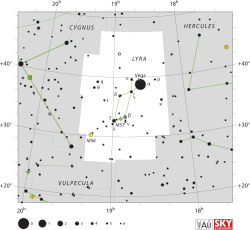| Observation data Epoch J2000 Equinox J2000 | |
|---|---|
| Constellation | Lyra |
| Right ascension | 18h 58m 56.62241s[1] |
| Declination | +32° 41′ 22.4003″[1] |
| Apparent magnitude (V) | 3.24[2] |
| Characteristics | |
| Spectral type | B9 III[3] |
| U−B color index | –0.125[4] |
| B−V color index | –0.04[2] |
| Astrometry | |
| Radial velocity (Rv) | –21.1[5] km/s |
| Proper motion (μ) | RA: –3.09[1] mas/yr Dec.: +1.11[1] mas/yr |
| Parallax (π) | 5.26 ± 0.27 mas[1] |
| Distance | 620 ± 30 ly (190 ± 10 pc) |
| Absolute magnitude (MV) | −3.14[6] |
| Details | |
| Mass | 5.76[7] M☉ |
| Radius | 13.28±1.15[2] R☉ |
| Luminosity | 2,430[7] L☉ |
| Surface gravity (log g) | 3.5±0.25[2] cgs |
| Temperature | 11000±100[2] K |
| Metallicity [Fe/H] | +0.15[7] dex |
| Rotational velocity (v sin i) | 65[2] km/s |
| Other designations | |
| Database references | |
| SIMBAD | data |
Gamma Lyrae, Latinised from γ Lyrae, and formally named Sulafat /ˈsuːləfæt/,[9][10] is the second-brightest star in the northern constellation of Lyra. With an apparent visual magnitude of 3.3,[4] it is readily visible to the naked eye. Parallax measurements yield an estimated distance of 620 light-years (190 parsecs) from the Sun. At that distance, the visual magnitude of the star is diminished by an extinction factor of 0.12±0.03 due to interstellar dust.[7]
- ^ a b c d e Cite error: The named reference
aaa474_2_653was invoked but never defined (see the help page). - ^ a b c d e f Cite error: The named reference
gordon2019was invoked but never defined (see the help page). - ^ Cite error: The named reference
aj74_375was invoked but never defined (see the help page). - ^ a b Cite error: The named reference
aaass65_2_405was invoked but never defined (see the help page). - ^ Cite error: The named reference
rgcrvwas invoked but never defined (see the help page). - ^ Cite error: The named reference
Anderson2012was invoked but never defined (see the help page). - ^ a b c d Cite error: The named reference
challouf2014was invoked but never defined (see the help page). - ^ Cite error: The named reference
SIMBADwas invoked but never defined (see the help page). - ^ Kunitzsch, Paul; Smart, Tim (2006). A Dictionary of Modern star Names: A Short Guide to 254 Star Names and Their Derivations (2nd rev. ed.). Cambridge, Massachusetts: Sky Pub. ISBN 978-1-931559-44-7.
- ^ "IAU Catalog of Star Names". Retrieved 28 July 2016.
